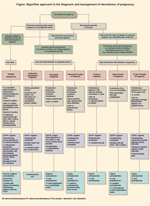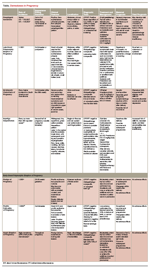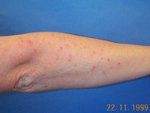Dermatoses of Pregnancy at a Glance
During pregnancy, every mother-to-be undergoes radical psychological and physiological changes (endocrinologic, immunologic, metabolic, or vascular) whose influence may trigger various skin manifestations, even during the very first weeks of gestation.
During pregnancy, every mother-to-be undergoes radical psychological and physiological changes (endocrinologic, immunologic, metabolic, or vascular) whose influence may trigger various skin manifestations, even during the very first weeks of gestation. These pregnancy-related cutaneous conditions, collectively grouped under the conceptual umbrella of “dermatoses of pregnancy,” can be disentangled into 4 distinct categories:
1. Common, physiologic skin changes that can accompany pregnancy; for example, striae gravidarum, melasma (also called chloasma, “mask of pregnancy”)
2. Changes in preexisting skin diseases (dermatoses coinciding with pregnancy)-past events with onset not related to a previous pregnancy; for example, atopic dermatitis, lupus erythematosus
3. Dermatoses specific to pregnancy-disorders known to develop only during pregnancy or during the postpartum period; for example, pemphigoid gestationis
4. Disorders related to pregnancy yet considered nonspecific to gestation; for example, impetigo herpetiformis (also called generalized pustular psoriasis of pregnancy)
FIGURE 1
Algorithm approach to the diagnosis and management of dermatoses of pregnancy.
Knowing how to deal with the dermatoses of pregnancy conditions is crucial, because some dermatoses, including pemphigoid gestationis, intrahepatic cholestasis of pregnancy, and impetigo herpetiformis, are associated with considerable potential for negative fetal outcomes such as prematurity, fetal distress, or even stillbirth. Others, such as polymorphic eruption of pregnancy, prurigo of pregnancy, and pruritic folliculitis of pregnancy, although not associated with fetal risks, can be caused by pruritic symptomatology, which is severely distressing for the mother.
This review offers practical clinical guidance and updated treatment strategies for each of these dermatoses of pregnancy and presents an algorithmic approach to pregnant patients who manifest skin-related conditions (Figure 1). At end of the article you will also find a Table summarizing the conditions as well as diagnosis and treatment approaches. In this context, I will use a recent pragmatic, clinically based classification scheme of the specific dermatoses of pregnancy1:
TABLE
Dermatoses in Pregnancy
- Pemphigoid gestationis (also known as herpes gestationis)
- Late-onset polymorphic eruption of pregnancy (polymorphic eruption of pregnancy, pruritic urticarial papules, and plaques of pregnancy)
- Early-onset polymorphic eruption of pregnancy (comprising the papular dermatoses of pregnancy: prurigo of pregnancy, atopic eruption of pregnancy, and pruritic folliculitis of pregnancy)
- Intrahepatic cholestasis of pregnancy (liver disorder of pregnancy; also known as cholestasis of pregnancy, obstetric cholestasis, recurrent jaundice of pregnancy, idiopathic jaundice of pregnancy, pruritus gravidarum, icterus gravidarum)
- Impetigo herpetiformis (pregnancy-related dermatosis-generalized pustular psoriasis of pregnancy)
PEMPHIGOID GESTATIONIS
Pemphigoid gestationis (PG)-previously known as herpes gestationis-is a rare autoimmune vesiculobullous disorder with severe pruritic manifestations. The condition occurs mainly in late pregnancy or in the puerperium.
Although PG seems to be characterized by a worldwide distribution rather than by a specific geographic prevalence, existent studies highlight different rates of incidence in various regions of the globe: the estimated incidence in North America is 1 in 50,000 pregnancies, 2 while the incidence is only 1 in 40,000 in the United Kingdom 3(even if, in this latter case, some researchers support incidences as high as up to 1 in 1700 pregnancies).4
In this context, it is worth noting that one of the basic tenets shared by these existing studies is the association between PG and the haplotypes HLA-DR3 (in 61%–80% of cases) and HLA-DR4 (in 52%–53% of cases).5 Existing literature suggests that the pathogenically relevant autoantigen is a 180 kDa epidermal protein, also termed “bullous pemphigoid-180,” “bullous pemphigoid antigen 2,” or “type XVII collagen”.6 Bullous pemphigoid antigen 2 is in fact a transmembrane glycoprotein of basal keratinocytes that consists of a large extracellular domain within the lamina lucida of the dermo-epidermal junction. The ectodomain contains more than 1000 amino acids, but the reactivity of the autoantibodies is directed against the N-terminal 45 amino acids of the 16th noncollagenous domain,7 which is located in the proximity of the cell membrane.
The autoantibodies are circulating, complement-fixing immunoglobulin G (IgG) antibodies of the subclass IgG1, formerly called “herpes gestationis factor,”7 which are also found in the skin and are formed in order to be directed against the bullous pemphigoid antigen 2 in the hemidesmosomes of the basal membrane zone (BMZ). The autoimmune response consists of immune complex deposition and complement activation (via the classical pathway),8,9 followed by the consecutive chemo-attraction and degranulation of eosinophils. The latter results in tissue damage (destruction of the BMZ) and blister formation.10
Strong direct and indirect evidence supports an autoimmune etiology for PG, and the condition has been seen in patients with other conditions that are autoimmune in nature, such as Grave disease, pernicious anemia, and Hashimoto thyroiditis. On the other hand, the recurrence of the disease when using oral contraceptives or during the premenstrual period supports the theory that hormonal factors play an essential role in the pathogenesis of PG.
Clinical Features
PG’s initial manifestations occur during the second (34% of patients) or third (34% of patients) trimester of pregnancy. According to Jenkins and colleagues,11 the onset can also occur during the first trimester (in 18% of patients), while only 14% of patients exhibit symptoms during the postpartum period.
The typical evolutionary pattern of PG consists of severe initial pruritus, which precedes the appearance of skin lesions, the latter appearing in the form of erythematous urticarial papules that evolve into plaques.
FIGURE 2a
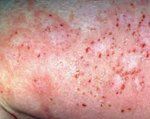
Highly pruritic abdominal rash in a 24-year-old woman’s first pregnancy. A biopsy and direct immunofluorescence confirmed the suspected diagosis of pemphigoid gestationis. (Image courtesy of Dr Scott Ross, ConsultantLive.) FIGURE 2b
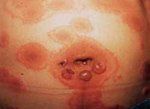
A 16-year-old patient with pemphigoid gestationis during the 38th week of her first pregnancy. Patient was affected with pruritic, hivelike, edematous, bullous lesions on her abdomen and legs. (Image courtesy of Dr Scott Ross, ConsultantLive.)
With a prevalence of 50% of cases,12,13 the typical localization of the lesions is in the abdominal region, almost always within or proximate to the umbilicus (Figure 2a and Figure 2b). Atypical patterns of lesions include involvement of the limbs, palms, or soles.
As lesions evolve-within days or weeks-into tense blisters (similar to those of bullous pemphigoid) with a generalized pemphigoid-like pattern of eruption, the diagnosis becomes more obvious. While the entire skin surface can theoretically be involved, the face, palms, soles, and mucous membranes are usually spared.2,14
Diagnostic Tests
Histopathologic and immunopathologic tests are the most important tools used to confirm a diagnosis of PG, as routine laboratory tests usually reveal no abnormalities. Histopathologic findings from lesional skin depend on the stage and severity of the disease. In the preblistering stage, edema in the upper and middle dermis can be identified with a predominant perivascular inflammatory infiltrate, composed of lymphocytes, histiocytes, and a variable number of eosinophils. In this stage, epidermal spongiosis and focal necrosis of the keratinocytes can also be observed.
On the other hand, the bullous stage reveals a subepidermal blister, which in fact is nothing but a histopathologic sine qua non feature located in the lamina lucida of the BMZ. In addition, numerous eosinophils are seen along the BMZ and in the bullous spaces.
Direct immunofluorescence (DIF) performed on perilesional skin is considered to be a veritable gold diagnostic standard for pemphigus gestationis; in 100% of cases, it reveals a bright linear deposition of C3 along the BMZ. In addition, in 25% to 30% of cases15 the presence of IgG (subclass IgG116) deposition can also be observed. Depending on the applied technique, indirect immunofluorescence (IIF) may show circulating IgG antibodies in 30% to 100% of cases.15 However, it is worth noting that there is no consistent correlation between autoantibody levels and disease severity, and although some authors do describe a correlation between the two5,7 (using enzyme-linked immunosorbent assay and immunoblot techniques), others insist that there is no correlation at all.9
Differential Diagnosis
In the preblistering stage it is almost impossible to distinguish pemphigus gestationis from late-onset polymorphic eruption of pregnancy, mainly due to the fact that both have clinical and histopathological overlap in this early stage. Some clinical aspects, such as the absence of striae gravidarum and the presence of skin lesions involving the umbilical area, may suggest the PG diagnosis. Nevertheless, in order to clearly elucidate it, it is imperative to perform DIF.
Bullous conditions coinciding with pregnancy such as bullous pemphigoid, dermatitis herpetiformis, linear immunoglobulin A disease (Berger disease), bullous systemic lupus erythematosus, erythema multiforme, bullous drug eruptions, or contact dermatitis 5 must also be excluded. In all these cases, the immunopathologic tests (DIF/IIF) play an important role in differentiating PG from other blistering disease states.
Treatment and Management
Treatment of PG is mandatory, with the dual goals of controlling pruritus and preventing blister formation. The exact therapeutic intervention is, however, dependent on the stage and on the severity of the disease.
In mild preblistering stages of PG, potent topical corticosteroids plus emollients with or without oral antihistamines (eg, loratadine and cetirizine) are sufficient.15 However, when blisters have arisen, the use of systemic corticosteroids is recommended (prednisolone, started at a dosage of 0.5-1 mg/kg/d). When the disease shows signs of improvement (usually in approximately 2 weeks), the use of prednisolone can be tapered (over several weeks) and maintained at the lowest effective dose. The prednisolone dose may be increased around the patient’s due date to prevent the characteristic flare-up of the disease at delivery or immediately postpartum.
For the affected neonates, treatment consists of wound care, because the condition is transient and usually has mild clinical manifestations. No specific treatment is typically required.
Evolution and Maternal Prognosis
The natural course of the disease consists of alternating exacerbations and remissions during pregnancy, with general improvement in the third trimester and flare-up at the time of delivery (in 50%-75% of patients5). PG tends to reoccur in all subsequent pregnancies, usually with an earlier onset and with increased severity compared to the initial pregnancy. Existent literature highlights that only a small number of pregnancies (approximately 5%-8%) are passed over (the so-called skip pregnancies).5,15
After delivery, exacerbations or recurrences have been reported-especially during the premenstrual period or after the use of oral contraceptives.5 For obvious reasons, in these cases, use of oral contraceptives is contraindicated.
Fetal Prognosis
In PG there is a passive transfer of IgG1 antibodies from the mother to the fetus, and up to 10% of newborns can develop a mild clinical picture, consisting of urticarial or vesicular skin lesions. All other cases seem to manifest a subclinical disease with no clinical lesions (the immunopathologic tests from the cord blood or neonatal skin do still demonstrate the presence of antibodies).5
Of importance is the increased inclination to develop fetal risks such as small-for-gestational-age babies and prematurity, which seem to suggest a low-grade placental insufficiency that is possibly associated with the use of systemic corticosteroids or with the pathophysiologic mechanism of the disease itself.11
Adrenal insufficiency must also be taken into consideration in the case of infants whose mothers were treated with systemic corticosteroids at higher dosages over a long period. Nevertheless, Gabbe17 suggested that the maternal-fetal gradient of prednisolone is only 10:1 and, as a consequence, fetal adrenal suppression is a rare sequel.
LATE-ONSET POLYMORPHIC ERUPTION OF PREGNANCY
FIGURE 3
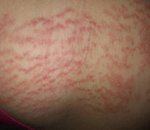
Late-onset polymorphic eruption of pregnancy at primigravida with onset at 2 weeks postpartum, with intensely pruritic urticarial papules within and/or adjacent to striae gravidarum on the abdomen.
Late-onset polymorphic eruption of pregnancy (late-onset PEP, also called polymorphic eruption of pregnancy largely in Europe or pruritic urticarial papules and plaques of pregnancy largely in the United States) is a benign, self-limited, pruritic, papulo-urticarial inflammatory disorder that usually affects the primigravida in the last trimester of pregnancy or in the immediate postpartum period (Figure 3). In contrast to PG, this disorder has minimal risk of recurrence in subsequent pregnancies.
Of note, patients with extensive maternal weight gain and with multiple gestation pregnancies (twins or triplets) are more susceptible to develop late-onset PEP.18,19
Despite the high incidence of the disorder (about 1:160 pregnancies15), the pathogenesis of late-onset PEP remains unclear. The dominant theories focus on hormonal and immunological factors, and consider the abdominal overdistension with increasing damage of the connective tissue as important. In theory, exposure of antigens within collagen bundles could promote an allergic-type reaction while generating skin lesions within striae gravidarum. In addition, some studies present the existence of altered maternal immune reactivity, claiming that in multiple pregnancies this can be exaggerated, and an abnormal reaction in the abdominal striae can occur.20
Clinical Features
Clinically, late-onset PEP starts on the abdomen within and/or adjacent to striae, with intensely pruritic small urticarial papules that eventually coalesce into erythematous plaques.20,21 A characteristic hallmark is the sparing of the umbilical region. More than 50% of cases develop polymorphous features such as papulovesicles or microvesicles overlying the striae gravidarum, urticarial lesions (in up to 40% of cases), target lesions similar to erythema multiforme (in up to 20% of cases), annular or polycyclic wheals (in 18% of patients), and, rarely, small bullae (as a result of coalescing vesicles). In the “classical” evolutionary pattern, the eruption remains located to the abdomen, buttocks, and proximal thighs, but in severe cases the eruption can spread widely to involve distant parts of the body, such as the arms, legs, or even more rarely the face and hands.21
Diagnostic Tests
Histopathology is nonspecific, revealing epidermal and papillary dermal edema; superficial and mid-dermal perivascular lymphohistiocytic infiltrate almost exclusively composed of T-helper lymphocytes, macrophages, and eosinophils (the latter being less prevalent than in pemphigus gestationis); and epidermal changes such as hyperkeratosis, parakeratosis, or acanthosis in older lesions.21
In ambiguous cases, when the clinical criteria prove to be insufficient and when there is a risk of a diagnostic confusion with PG, immunopathologic tests should be performed. DIF and IIF are essentially always negative in late-onset PEP. Routine laboratory investigations are usually within the normal ranges, but in some cases increased maternal serum IgE levels can be found.
Differential Diagnosis
First, the clinician should exclude other specific dermatoses of pregnancy (PG, papular dermatoses of pregnancy such as prurigo of pregnancy, and pruritic folliculitis of pregnancy). The polymorphous clinical framework manifested by the disease makes it difficult for the clinician to distinguish it from other related or specific dermatoses of pregnancy, and therefore it can be a real challenge to distinguish late-onset PEP from an early presentation of PG (in the prebullous stage). In this case, immunopathologic tests become indispensable.
The exclusion of the papular dermatoses of pregnancy (prurigo of pregnancy and pruritic folliculitis of pregnancy) is based on the onset of the condition. While the papular dermatoses of pregnancy exhibit an earlier onset in pregnancy, late-onset PEP initially occurs in the last part of the pregnancy. In these instances, there are no specific diagnostic tests and, more importantly, a clinical and histopathological overlap might exist between these conditions.
The exclusion of the intrahepatic cholestasis of pregnancy can be easily made when the total serum bile acid levels are normal. The differential diagnosis must also include conditions coincidental to pregnancy such as scabies, drug eruptions, allergic reactions, and erythema multiforme.22
Treatment and Management
The aim of treatment is to control pruritus and to limit the development of new skin lesions. As late-onset PEP is self-limited, symptomatic treatment with topical corticosteroids (such as mometasone, halcinonide, and betamethasone valerate 0.1% applied twice daily plus topical antipruritic medication [menthol, polidocanol, or pramoxine] or emollient bath additives) seem to be sufficient for cessation of pruritus. If not, systemic antihistamines can be added (loratadine or cetirizine). Systemic corticosteroids are rarely required.
Evolution and Maternal Prognosis
The maternal prognosis is excellent. The lesions usually resolve within 4 to 6 weeks; fine scaling on the affected areas may appear. There is no postinflammatory pigmentary change or scarring of the skin.21
Fetal Prognosis
The fetal prognosis is also excellent, with neither cutaneous nor systemic involvement in the newborn.18
EARLY-ONSET POLYMORPHIC ERUPTION OF PREGNANCY
Early-onset polymorphic eruption of pregnancy (early-onset PEP) comprises the papular dermatoses of pregnancy: prurigo of pregnancy, atopic eruption of pregnancy, and pruritic folliculitis of pregnancy.
Prurigo of Pregnancy
Prurigo of pregnancy (PP) is a benign, pruritic dermatosis of pregnancy with excoriated papules and nodules on the limbs and/or trunk, typical onset in mid-pregnancy (about 25-30 weeks’ gestation),23 and variable recurrence in subsequent pregnancies. PP has a reported incidence of 1 in 300 pregnancies.24
FIGURE 4
Prurigo of pregnancy.
Clinically, PP’s initial manifestation includes pruritic erythematous papules and nodules on the extensor surfaces of the limbs and/or trunk (Figure 4). Later, the picture can become polymorphic with excoriated, crusted, and eczematous lesions. Rarely, follicular lesions can be present (but not blisters).24 The skin lesions evolve during gestation and disappear within weeks after delivery.
Histopathology is nonspecific, revealing a chronic inflammatory cell infiltrate in the upper dermis with occasional epidermal involvement.25 Immunopathologic tests (DIF/IIF) are negative. Serologic tests are usually normal, although some patients might present elevated serum IgE levels.
Differential diagnosis should also include (initially) other specific dermatoses of pregnancy (eg, late-onset PEP). In addition, several pruritic dermatoses unrelated to and coinciding with gestation (eg, atopic dermatitis) should always be ruled out. Other conditions like scabies, drug eruptions, and arthropod bites should also be considered.
PP is treated with moderately potent topical corticosteroids and oral antihistamines. Additional measures might consist of emollients with urea (3%-10%) or antipruritic additives such as menthol or polidocanol or pramoxine.
Maternal and fetal prognosis is good, without adverse effects for either the mother or the newborn.
Pruritic Folliculitis of Pregnancy
Pruritic folliculitis of pregnancy (PFP) is a benign pruritic dermatosis of pregnancy with follicular pustular and papular lesions situated on the trunk or generalized, with a typical onset occurring during the second trimester of pregnancy, and with exceptional recurrence in subsequent pregnancies.26 Studies reveal an incidence of PFP of about 1 in 3000 pregnancies.26
Clinically, the lesions consist of small (3-5 mm) pruritic erythematous papules on the upper trunk.24 Later, the eruption becomes generalized, with follicular, erythematous papules and pustular lesions. The classical pattern reveals skin lesions, which evolve during gestation stages and disappear within weeks after delivery. The key clinical feature is the folliculocentric localization of skin lesions.
Histopathology is nonspecific, revealing features of an acute folliculitis such as intraluminal pustules with neutrophils, lymphocytes, macrophages, and some eosinophils. At the dermis level there is a mild superficial edema with a perivascular infiltrate of lymphohistiocytes and some eosinophils.26 Staining for microorganisms (eg, Gram, Fite, and periodic acid-Schiff) is negative and reveals sterile folliculitis. However, some authors reported the presence of Gram-positive cocci or bacilli.21 Immunopathologic tests (DIF/IIF) are negative. Serologic tests are usually normal, although serum levels of androgens can be elevated in some patients.
Differential diagnosis should initially include other specific dermatoses of pregnancy (eg, late-onset PEP, PG, or PP). The absence of bullous lesions together with the nonspecific histopathologic findings and negative DIF should, however, help differentiate PFP from PG. The absence of striae gravidarum and urticarial lesions, typical for late-onset PEP, helps in distinguishing PFP from this condition. Distinction from PP is also relatively simple because, unlike PFP, PP has nonfollicular lesions and a predilection for extremities.
In addition, several papulo-pustular dermatoses unrelated to and coinciding with gestation (eg, acne, acneiform drug eruptions, routine bacterial folliculitis, and hot tub folliculitis) should be ruled out.
PFP is treated with low-potency corticosteroids, benzoyl peroxide 10%, a mixture of both, or narrow band UVB phototherapy. Maternal and fetal prognosis is good, without adverse effects to either.
Atopic Eruption of Pregnancy
Atopic eruption of pregnancy (AEP) is a benign pruritic dermatosis of pregnancy with eczematous or papular lesions in patients with a personal or family history of atopy and/or elevated total IgE levels. AEP recurs in subsequent pregnancies due to the atopic background and has a high prevalence of 50% among pruritic dermatoses of pregnancy.27 A positive diagnosis is always based on the exclusion of other pregnancy-specific dermatoses or coincidental conditions. AEP comprises PP, PFP, and eczema in pregnancy. The etiology of AEP is still not fully elucidated.
FIGURE 5
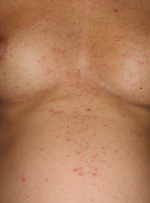
Atopic eruption of pregnancy (generalized maculopapular rash and pustules) in a 26-year-old woman presenting at 30 weeks gestation of her first pregnancy. (From
Dermatology Nursing
, 2009, Volume 21, Number 2, pp. 70-74, 81. Reprinted with permission of the publisher, Jannetti Publications, Inc., East Holly Avenue, Box 56, Pitman, NJ 08071-0056; Phone (856) 256-2300; FAX (856) 589-7463;
www.dermatologynursing.net
.)
Clinically, the skin lesions consist of prurigo lesions, eczematous-looking skin lesions (located in the typical atopic sites such as the neck, dcolletage, or flexural surfaces of extremities), and secondary skin lesions, due to scratching (Figure 5).
Histopathology is nonspecific. Immunopathologic tests (DIF/IIF) are negative. Serologic tests are usually normal, although elevated levels of total serum IgE antibodies and eosinophilia may be found in 20% to 70% of cases.27
Differential diagnosis should initially include specific dermatoses of pregnancy (PG, late-onset PEP, and ICP). In addition, several pruritic dermatoses unrelated to and coinciding with gestation (eg, scabies, pityriasis rosea, allergic rashes, drug eruptions, and viral and bacterial exanthema) should always be ruled out.
Treatment consists of moderately potent topical corticosteroids and oral antihistamines (eg, chlorphenamine, clemastine, loratadine, or cetirizine). Additional measures consisting of emollients with urea (3%–10%) or antipruritic additives such as menthol polidocanol or pramoxine are indicated.
Maternal and fetal prognosis is good, without adverse effects to the newborn. The disease manifests throughout pregnancy, affecting all 3 trimesters. AEP recurs in subsequent pregnancies due to the atopic background.
INTRAHEPATIC CHOLESTASIS OF PREGNANCY
Intrahepatic cholestasis of pregnancy (ICP; also called cholestasis of pregnancy, obstetric cholestasis, recurrent jaundice of pregnancy, idiopathic jaundice of pregnancy, pruritus gravidarum, or icterus gravidarum) is a rare pregnancy-related liver disorder characterized by a reversible form of hormonally triggered cholestasis that typically develops in genetically predisposed individuals in late pregnancy. It was considered appropriate to include ICP in the classification scheme of the specific dermatoses of pregnancy only because of the impressive association with fetal risks.
The geographic prevalence of ICP reflects a higher incidence of the condition in South America (28% among Araucanian Indian women in Chile; 9% in Bolivia) and in Scandinavia (2.4%). In the United States, Canada, Australia, and Europe (other than Scandinavia) the prevalence is lower (0.1%-1.5%).28,29
The pathogenesis of ICP seems to be multifactorial (hormonal [estrogen and progesterone metabolites], genetic, and exogenous [environmental and/or dietary]), with a strong interaction between all these factors. The result is a defect in the excretion of bile salts with the consequence of elevated serum bile acids. For the mother this means pruritus, but for the fetus it could mean placental anoxia and cardiac depression due to the transfer of the toxic bile acids into the fetal circulation.
Clinical Features
ICP usually starts during the third trimester of pregnancy (after the 30th week),28 but in 25% of cases it appears as early as the late second trimester of pregnancy. Rarely, it may occur even earlier, in the first trimester of pregnancy (10% of cases).29,30,31
The clinical findings of ICP are characterized by the presence of severe pruritus and secondary skin lesions due to scratching (excoriations and, with progression, prurigo nodules).15,29 The shins and lower arms are the most common affected sites, but other body sites such as the buttocks or abdomen can also be affected.
Some cases can develop gastrointestinal symptoms such as mild nausea or discomfort in the upper right quadrant.28 In addition, there is an increased risk for the development of cholelithiasis.
In severe cases with concomitant extrahepatic cholestasis, jaundice can be present (about 10% of cases).32 This occurrence can be associated with steatorrhea with decreased absorption of fat-soluble vitamins (eg, vitamin K) and weight loss. There can be an increased risk of intra- and postpartum hemorrhage if treatment is not supplemented with adequate doses of vitamin K.29 Exceptionally rarely, jaundice can occur without pruritus.29
Diagnostic Tests
The elevation of serum bile acid levels in the presence of generalized pruritus represents the hallmark findings for the diagnosis of ICP.
Liver function tests must be performed for every pregnant woman with pruritus. In healthy pregnancies, the total serum bile acid level is slightly higher (6.6 ± 0.3 μmol/L vs 5.7 ± 0.4 μmol/L in nonpregnant women)33; levels up to 11.0 μmol/L are accepted as normal in late gestation.34
Alanine aminotransferase can be raised in 20% to 60% or 30% of cases, respectively, with a 2- to 10-fold elevation.32,35 Hyperbilirubinemia (up to 100 μmol/L or 5 mg/dL) is noted in only 10% to 20% of cases.29γ-Glutamyltransferase can be normal or slightly raised in ICP, while in normal late pregnancy it is typically lower. Plasma protein electrophoresis may show slightly decreased albumin, moderately increased α2-globulins, and very increased β-globulins.36
Histopathology is nonspecific and DIF/IIF tests are negative.
Differential Diagnosis
First, other dermatoses of pregnancy such as PG, PEP, and the papular dermatoses of pregnancy (prurigo of pregnancy, PFP) have to be excluded. Even in cases with clinical overlap, the absence of primary skin lesions and the elevation of the total serum bile acid levels (> 11 μmol/L) simplify the diagnosis. Other conditions coinciding with pregnancy (allergic reactions, viral and/or bacterial rashes, and scabies) have to be excluded. In cases with jaundice, conditions to exclude include acute fatty liver of pregnancy, viral hepatitis, preeclampsia with increased liver enzymes, hyperemesis gravidarum, bile drug obstruction, metabolic diseases, hemolytic diseases, drug icterus, or hyperbilirubinemic states.37
Treatment and Management
The major aim of treatment is to decrease bile acid levels in order to sustain the pregnancy and diminish the prevalence of fetal risks and maternal symptoms.
Ursodeoxycholic acid (UDCA) represents the first-line treatment of ICP, and is the only treatment that has been proven to reduce maternal symptoms (eg, pruritus) and, more importantly, the only treatment with unquestionable positive effects to fetal outcome.38,39 UDCA is not licensed for use in pregnancy and is considered an off-label use, therefore requiring special patient information and approval.
The recommended dosage of UDCA is 15 mg/kg/d or, independent of bodyweight, 1 g/d.15 The drug can be administered either as a single daily dose or divided into 2 to 3 doses, until delivery. Occasionally, adverse effects, such as mild diarrhea may occur.
In ICP the obstetric management focuses on the following actions:
- Weekly fetal cardiotocographic monitoring starting at 34 weeks’ gestation.
- In mild cases, induction of labor at 38 weeks’ gestation.
- In severe cases, induction of labor at 36 weeks’ gestation.
- Weekly assessment of serum bile acids, transaminases, and bilirubin.
- Checking prothrombin time in severe cases, especially those complicated by steatorrhea.32
Evolution and Maternal Prognosis
The prognosis for the mother is generally good. After delivery, the maternal symptomatology (pruritus, jaundice) usually resolves within days or weeks.29 ICP is not associated with an increased risk of earlyspontaneous abortion. There is a possible risk of recurrence of ICP in subsequent pregnancies and a possible association of recurrence with hormonal contraception.29
Fetal Prognosis
ICP is associated with a high prevalence of reduced fetal prognosis, which correlates with higher bile acid levels, particularly those more than 40 μmol/L.29 The most common risk is that of premature birth (19%-60%), followed by intrapartal fetal distress (22%-33%) and stillbirth (1%-2%).29 In cases complicated by concomitant extrahepatic cholestasis, vitamin K deficiency induces a high risk of antepartum fetal hemorrhage.29 In such cases, prompt diagnosis, specific therapy, close obstetric monitoring, and intensive fetal surveillance are mandatory.
In ICP, the frequency of fetal malformations is not increased. Birth weights are adequate for gestational age, and breastfeeding is not contraindicated.23
IMPETIGO HERPETIFORMIS
Impetigo herpetiformis (IH, also called generalized pustular psoriasis of pregnancy) is a rare pustular dermatosis related to pregnancy (rather than being considered a specific dermatosis due to pregnancy), with a typical onset in the second half of pregnancy (usually during the third trimester of pregnancy), resolution after delivery, possible recurrence in subsequent pregnancies, and increased fetal risk such as stillbirth, neonatal death, and fetal abnormalities due to placental insufficiency.
Its pathogenesis remains unclear mainly due to the low incidence of this condition (no more than 200 reported cases).24 Yet possible triggering factors have been suggested: high levels of progesterone during the last trimester of pregnancy, low levels of calcium, or reduced levels of epidermal skin-derived antileukoproteinase (also known as elafin) activity implicated in the formation of epidermal pustules.40
Of note, the most frequently discussed hypotheses conceptualize IH as a form of pustular psoriasis and not as a distinct dermatosis, but all consider it a pregnancy-related condition.
Clinical Features
FIGURE 6
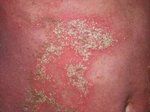
Impetigo herpetiformis in the postpartum period: erythematous plaques with polycyclic edges covered with widespread, tiny, green-yellow pustules on the abdomen.
IH is clinically characterized by the presence of widespread, tiny, superficial, green-yellow pustules on an erythematous, inflamed background, most characteristically arranged in rings or groups at the margins of the lesion (herpetiform pattern) (Figure 6). In the central area of the lesions, the pustules break down, with subsequent crusting and possible impetiginization.41 Pruritus is usually absent. Initially the eruption begins in the flexures (inguinal region) and has the potential to spread over the entire body in a centrifugal pattern.
The face, hands, and feet are usually not affected, although such atypical manifestations have been reported: mucous membrane erosions, such as on the buccal mucosa, the tongue, and esophagus (rarely); and nail bed involvement with subungual pustulosis and consequent onycholysis.42,43 The disease can be associated with constitutional symptoms such as pain, fever, chills, vomiting, delirium, nausea, diarrhea, tetany (due to hypocalcemia), lymphadenopathy, seizures, and malaise. In addition, severe dehydration, prostration, and convulsions can occur.44,45 After resolution of the lesions, postinflammatory hyperpigmentation is routinely observed.
Diagnostic Tests
Histopathology resembles, to some extent, that of pustular psoriasis. The presence of subcorneal spongiform pustules filled with neutrophils, and perivascular infiltrates with admixed lymphocytes and neutrophils, are suggestive of IH. Some histologic elements more typical for pustular psoriasis, such as parakeratosis and psoriasiform hyperplasia, may also be present in IH. DIF and IIF are negative.
Laboratory findings usually demonstrate leukocytosis with neutrophilia; elevated erythrocyte sedimentation rate; low maternal serum calcium, phosphate, and vitamin D levels (due to hypoparathyroidism); hypoalbuminemia; and iron deficiency anemia.44,45 Blood and pustule cultures are sterile.
Differential Diagnosis
First, exclude the specific dermatoses of pregnancy like PG or PEP; second, exclude the bullous dermatoses that coincide with pregnancy, such as bullous pemphigoid, dermatitis herpetiformis (Duhring disease), pemphigus vulgaris, or acute generalized exanthematous pustulosis. Other cutaneous entities characterized clinically by pustule formation (gonococcemia, subcorneal pustular dermatosis, candidiasis) may also be considered in the differential diagnosis.
Treatment and Management
The aim of the treatment is to minimize the impact of the disease-both in the mother and in the child. Systemic corticosteroids are considered the first-line treatment. In the United States, prednisone is normally initiated at a dosage of 0/5-1.0 mg/kg body weight. Outside the United States, prednisolone is normally initiated at a dosage of 15 to 30 mg/d. The dosage can be increased to 60 to 80 mg/d; after which, in nonresponding or refractory cases, other treatment should be considered-either as single agent or in combination with oral corticosteroids.46 Prednisolone is nonteratogenic but, theoretically, its use might generate some complications such as premature rupture of membranes, gestational diabetes mellitus, or macrosomia.47
Although there are limited human data regarding the use of cyclosporine (ciclosporin), the drug is considered to be the second-line treatment in IH since only early rupture of membranes with no significant teratogenic consequences have been noted.48-51 After pregnancy, other agents used in psoriasis (retinoids, oral psoralens and UVA, and methotrexate) may be utilized for disease refractory to systemic corticoids. If there is secondary skin infection, antibacterials must be used.
In order to maintain proper homeostasis, supportive therapy with fluids and electrolytes should be added as needed. Hypocalcemia must be promptly corrected because it might play a role in the pathogenesis of impetigo herpetiformis. In very severe cases, pregnancy may be terminated by induction of labor or via cesarean delivery.52,53
Evolution and Maternal Prognosis
At present, maternal prognosis is good even in severe cases of IH. However, in order to avoid serious complications such as delirium, convulsions, and tetany due to hypocalcemia, early recognition and prompt therapy (intravenous calcium gluconate) is essential.
Fetal Prognosis
In contrast to maternal prognosis, fetal prognosis is not as good. Major fetal complications (stillbirth, neonatal death, and fetal abnormalities) generated by placental insufficiency are possible, and may occur even in the face of successful clinical control from the maternal aspect.41,45,52
References:
1. Roth MM.Pregnancy dermatoses: diagnosis, management, and controversies. Am J Clin Dermatol. 2011;12(1)25-41.
2. Yancey KB.Herpes gestationis. Dermatol Clin. 1990;8:727-734.
3. Black MM.Progress and new directions in the investigation of the specific dermatoses of pregnancy. Keio J Med. 1997;46:40-41.
4. Roger D, Vaillant L, Fignon A, et al.Specific pruritic diseases of pregnancy. A prospective study of 3192 pregnant women. Arch Dermatol. 1994;130:734-739.
5. Jenkins RE, Shornick J. Pemphigoid gestationis. In: Black MM, Ambros-Rudolph C, Edwards L, et al., eds. Obstetric and gynecologic dermatology. 3rd ed. London: Mosby;2008:37-47.
6. Zillikens D. Pemphigoid gestationis: immunological aspects. JEADV. 2004; 18(Suppl 2):6-42.
7. Zillikens D. Pemphigoid gestationis: recent advances [abstract]. JEADV. 2003;17(Suppl 3):7.
8. Carruthers JA, Ewins AR.Herpes gestationis: studies on the binding characteristics, activity and pathogenetic significance of the complement-fixing factor. Clin Exp Dermatol. 1978;31:38-44.
9. Shornick JK. Dermatoses of pregnancy. Semin Cutan Med Surg. 1998;17:172-181.
10. Scheman AJ, Hordinsky MD, Groth DW, et al.Evidence for eosinophil degranulation in the pathogenesis of herpes gestationis. Arch Dermatol. 1989;125:1079-1083.
11. Jenkins RE, Hern S, Black MM.Clinical features and management of 87 patients with pemphigoid gestationis. Clin Exp Dermatol. 1999; 24: 255-259.
12. Shornick JK, Bangert JL, Freeeman RG.Herpes gestationis: clinical and histologic features of twenty-eight cases. J Am Acad Dermatol. 1983;8:214-224.
13. Shornick JK, Meek TJ, Nesbitt LT, et al.Herpes gestationis in blacks. Arch Dermatol. 1984;120:511-513.
14. Shornick JK.Herpes gestationis. J Am Acad Dermatol. 1987;17:539-556.
15. Paunescu MM, Feier V, Paunescu M, et al.Dermatoses of pregnancy. Acta Dermatovenerol Alp Panonica Adriat. 2008;17(1):4-11.
16. Jenkins R, Shornick JK, Black MM. Pemphigoid gestationis. JEADV. 1993;2:163-173.
17. Gabbe SG.Drug therapy in autoimmune disease. Clin Obstet Gynecol. 1987;26:635-641.
18. Rudolph CM, Al-Fares S, Vaughan-Jones SA, et al.Polymorphic eruption of pregnancy: clinicopathology and potential trigger factors in 181 patients. Br J Dermatol. 2006;154:54-60.
19. Elling SV, McKenna P, Powell FC. Pruritic urticarial papules and plaques of pregnancy in twin and triplet pregnancies. JEADV. 2000;14:378-381.
20. Ahmadi S, Powell F. Pruritic urticarial papules and plaques of pregnancy: current status. Australas J Dermatol. 2005;46:53-60.
21. Al-Fares S, Vaughan-Jones S, Black MM.The specific dermatoses of pregnancy: a re-appraisal. J Eur Acad Dermatol Venereol. 2001;15:197-206.
22. Ambros-Rudolph C, Black MM. Polymorphic eruption of pregnancy. In: Black MM, Ambros-Rudolph C, Edwards L, et al, eds. Obstetric and gynecologic dermatology. 3rd ed. London: Mosby; 2008:49-55.
23. Black MM. Pregnancy dermatoses: moving towards a better understanding. 64th Annual Meeting of American Academy of Dermatology; Mar 3-7, 2006; San Francisco.
24. Nasser N, Sasseville D. Dermatologic diseases of pregnancy [in French]. Dermatologie-Conferences Scientifiques. 2006;5(3):1-6.
25. Kroumpouzos G, Cohen LM. Dermatoses of pregnancy. J Am Acad Dermatol. 2001;45(1):1-19.
26. Karen JK, Keltz Pomeranz M. Skin changes and diseases in pregnancy. In: Wolff K, Goldsmith LA, Katz SI, et al, eds. Fitzpatrick’s dermatology in general medicine. Vol. 1. 7th ed. New York: McGraw Hill Medical; 2003 955-962.
27. Ambros-Rudolph CM, Mullegger RR, Vaughan-Jones SA, et al.The specific dermatoses of pregnancy revisited and reclassified: results of a retrospective two-center study on 505 pregnant patients. J Am Acad Dermatol. 2006;54:395-404.
28. Kroumpouzos G. Intrahepatic cholestasis of pregnancy. JEADV. 2002;16:316-318.
29. Lammert F, Marschall HU, Glantz A, et al.Intrahepatic cholestasis of pregnancy: molecular pathogenesis, diagnosis and management. J Hepatol. 2000;33:1012-1021.
30. Ambros-Rudolph C. Intrahepatic cholestasis of pregnancy. In: Black MM, Ambros-Rudolph C, Edwards L, et al, eds. Obstetric and gynecologic dermatology. 3rd ed. London: Mosby;2008:57-63.
31. Huchzermeyer H. Leber und Schwangerschaft. Bern: Huber; 1978.
32. Riosecco AJ, Ivankovic MB, Manzur A, et al.Intrahepatic cholestasis of pregnancy: a retrospective case-control study of perinatal outcome. Am J Obstet Gynecol. 1994;170:890-895.
33. Jeppsson S, Laurell CB, Rannevik G.Plasma protein after use of estrogen and-or progestogen in women with and without recurrent cholestasis during previous pregnancies. Scand J Clin Lab Invest. 1973;31:33-36.
34. Brites D, Rodrigues CM, Oliveira N, et al.Correction of maternal serum bile acid profile during ursodeoxycholic acid therapy in cholestasis of pregnancy. J Hepatol. 1998;28:91-98.
35. Milkiewicz P, Gallgher R, Chambers J, et al.Obstetric cholestasis of pregnancy with elevated gamma glutamyl transpeptidase: incidence, presentation, and treatment. J Gastroenterol Hepatol. 2003;18:1283-1286.
36. Forkman B, Ganrot PO, Gennser G, et al.Plasma protein pattern in recurrent cholestasis of pregnancy. Scand J Clin Lab Invest Suppl. 1972;124:89-96.
37. Schmid R, Haemmerli UP. Schwangerschaftsikterus. In: Beck K, ed. Ikterus. Stuttgart: Schattauer; 1968:227-231.
38. Beuers U, Boyer JL, Paumgartner G. Ursodeoxycholic acid in cholestasis: potential mechanisms of action and therapeutic applications. Hepatology. 1998;28:1449-1453.
39. Poupon RE, Lindor KD, Cauch-Dudek K, et al.Combined analysis of randomized controlled trials of ursodeoxycholic acid in primary biliary cirrhosis. Gastroenterology. 1997;113:884-890.
40. Kuijpers AL, Schalkwijk J, Rulo HF, et al.Extremely low levels of epidermal skin-derived antileucoproteinase in a patient with impetigo herpetiformis. Br J Dermatol. 1997;137:123-129.
41. Sauer GC, Geha BJ. Impetigo herpetiformis. Arch Dermatol. 1961;83:173-180.
42. Henson TH, Tuli M, Bushore D, et al.Recurrent pustular rash in a pregnant woman. Arch Dermatol. 2000;136:1055-1060.
43. Winton GB, Lewis CW. Dermatoses of pregnancy. J Am Acad Dermatol. 1982;6:977-998.
44. Sasseville D, Wilkinson RD, Schnader JY. Dermatoses of pregnancy. Int J Dermatol. 1981;20(4):223-241.
45. Camp RD. Generalized pustular psoriasis of pregnancy. In: Champion RH, Burton JL, Burns DA, et al., eds. Textbook of dermatology. 6th ed. London: Blackwell Scientific Publications; 1998:1639-1640.
46. Wolf Y, Groutz A, Wilman I, et al. Impetigo herpetiformis during pregnancy: case report and review of literature. Acta Obstet Gynecol Scand. 1995;74:229-232.
47. Fitzsmons R, Greeberger PA, Patterson R.Outcome of pregnancy in women requiring corticosteroids for severe asthma. J Allergy Clin Immunnol. 1986;78:349-353.
48. Imai N, Watanabe R, Fujiwara H, et al. Successful treatment of impetigo herpetiformis with oral cyclosporine during pregnancy. Arch Dermatol. 2002;138:128-129.
49. Finch TM, Tan CY. Pustular psoriasis exacerbated by pregnancy and controlled by cyclosporine A. Br J Dermatol. 2000;142:582-584.
50. Meinardi MM, Westerhof W, Bos JD.Generalized pustular psoriasis (von Zumbusch) responding to cyclosporine A. Br J Dermatol. 1987;116:269-270.
51. Valdes R, Nunez T, Pedraza S, et al. Recurrent impetigo herpetiformis: successfully managed with cyclosporine. Report of one case [in Spanish]. Rev Med Chile. 2005;133:1071-1074.
52. Oumeish OY, Farraj SE, Bataineh AS.Some aspects of impetigo herpetiformis. Arch Dermatol. 1982;118:103-105.
53. Lim KS, Tang MB, Ng PP.Impetigo herpetiformis-a rare dermatosis of pregnancy associated with prenatal complications. Ann Acad Med Singapore. 2005;34:565-568.
Recap on reproductive rights with David Hackney, MD, MS
December 20th 2022In this episode of Pap Talk, we spoke with David Hackney, MD, MS, maternal-fetal medicine physician at Case Western Reserve University and chair of ACOG's Ohio chapter for a full recap of where restrictions on reproductive rights have been and where they're going.
Listen
In this episode of Pap Talk, Gloria Bachmann, MD, MSc, breaks down what it means to be a health care provider for incarcerated individuals, and explores the specific challenges women and their providers face during and after incarceration. Joined by sexual health expert Michael Krychman, MD, Bachmann also discusses trauma-informed care and how providers can get informed.
Listen
No link found between hormonal contraception and clitoral adhesion severity
February 28th 2025A recent study presented at the ISSWSH 2025 Annual Meeting found no significant association between hormonal contraceptive use and the severity of clitoral adhesions, though researchers emphasize the need for further investigation.
Read More

